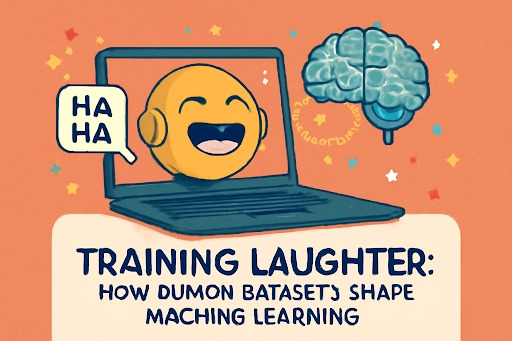Training Laughter: How Humor Datasets Shape Machine Learning

Humor has always been an essential part of human communication. It helps break the ice, relieve tension, and even make difficult conversations more enjoyable. But have you ever wondered how machines learn to understand humor? Thanks to advancements in artificial intelligence (AI) and machine learning (ML), computers can now recognize, generate, and even deliver jokes. The secret behind this transformation? Humor datasets.
In this article, we’ll dive into how humor datasets shape machine learning, the challenges involved, and how tools like Adobe Express meme maker are paving the way for AI to develop a sense of humor. We’ll explore actionable insights and the research that drives these innovations, ensuring AI is able to engage with humor like never before.
What Are Humor Datasets?
A humor dataset is essentially a collection of jokes, puns, memes, and humorous content that is used to train machine learning models. These datasets serve as a training ground for AI to understand the different aspects of humor, such as timing, wordplay, and delivery. Much like how humans learn humor through experience and exposure, AI models use these datasets to ‘learn’ the intricacies of comedic elements.
Humor datasets often contain a variety of humor types, such as:
- Wordplay (e.g., puns and double entendres)
- Physical comedy (though difficult to replicate in text)
- Cultural references (which vary by region)
- Dark humor (which can be controversial)
- Situational humor (which depends on context)
By feeding these datasets into machine learning models, researchers enable AI systems to recognize patterns in humor and replicate them in a way that makes sense to human users.
The Role of Humor in AI and Machine Learning
Why is humor important for AI? It’s not just about making machines funnier (though that’s certainly a perk). Humor plays a significant role in making AI systems more engaging, relatable, and human-like. Imagine a chatbot that can crack a joke in the middle of a conversation or an AI-powered meme generator that produces memes that truly make you laugh. That’s the power of humor datasets.
Humor can also enhance the effectiveness of human-computer interactions. If an AI can successfully use humor to lighten a conversation, it can create a more pleasant user experience. In fact, studies have shown that humor in digital interfaces can improve customer satisfaction, increase brand engagement, and even lead to higher conversion rates. After all, who doesn’t love a good laugh?
Challenges in Teaching AI Humor
While teaching AI to understand humor sounds like a fun challenge, it’s not without its difficulties. One of the main hurdles is that humor is inherently subjective. What makes one person laugh might not have the same effect on someone else. This subjectivity can make it difficult for AI to generate humor that resonates universally.
Here are a few key challenges:
- Cultural differences: Humor varies greatly across cultures. What might be funny in one country could be confusing or offensive in another.
- Contextual understanding: Humor often relies on context, timing, and shared knowledge. Machines, however, struggle to understand context in the same way humans do.
- Sensitivity: Some types of humor (e.g., dark or offensive humor) can be harmful or inappropriate, and machines must be trained to avoid crossing these lines.
These challenges highlight the complexity of humor and why datasets must be carefully curated. The inclusion of diverse, inclusive, and well-balanced content in these datasets is crucial to prevent AI from generating offensive or inappropriate humor.
Humor Datasets: What’s Inside?
Humor datasets can be categorized into several types, each containing different types of humorous content. Let’s break down some common examples:
1. Text-Based Humor
This category includes jokes, puns, riddles, and one-liners. These types of humor are often linguistic, relying on wordplay and syntax to generate laughter. A well-known example is the “Knock-Knock” joke format.
- Example: Why don’t skeletons fight each other? They don’t have the guts.
2. Memes
Memes are a staple of internet humor. These often combine images with text to create comedic situations. Datasets may include memes sourced from social media platforms, forums, and meme-sharing sites.
Tools like Adobe Express meme maker are helping AI understand the visual and textual elements that make memes so effective at eliciting humor. AI systems can learn not just from the text of the meme but from the image composition, style, and overall tone.
3. Stand-Up Comedy Transcripts
Stand-up comedy routines are a goldmine for humor datasets. Transcripts of performances by comedians are used to teach AI about timing, punchlines, and audience reactions. These datasets help AI recognize different comedic styles, whether it’s observational humor, satire, or dry humor.
4. Natural Language Processing (NLP) Humor
NLP-based humor datasets focus on jokes that are crafted with linguistic flair, such as puns, rhymes, and wordplay. For example, AI can analyze puns and how a single word can have multiple meanings in different contexts.
- Example: Why did the scarecrow win an award? Because he was outstanding in his field.
The Future of Humor in Machine Learning
As AI continues to evolve, the potential for humor-driven applications expands beyond chatbots and meme creators. Here are some exciting developments:
- Personalized Humor: In the future, AI could learn your personal sense of humor. By analyzing your past interactions with AI, it could tailor jokes and memes specifically to your tastes.
- AI in Entertainment: From personalized stand-up routines to comedy writers powered by AI, humor could become a driving force in the entertainment industry. Imagine AI-generated sitcoms or comedy sketches that appeal to specific audiences based on their humor preferences.
- Emotional Intelligence: Humor is a key component of emotional intelligence, and AI’s understanding of humor could improve its ability to empathize with human users. This could lead to more emotionally aware AI, capable of offering humor to brighten someone’s day when they’re feeling down.
Actionable Insights for Developers and Marketers
For developers and marketers working with AI, incorporating humor into your applications can significantly improve user engagement. Here are some actionable tips:
- Curate diverse humor datasets: Ensure that the humor used to train AI reflects diverse cultural perspectives and avoids harmful stereotypes.
- Incorporate humor in customer service chatbots: Use humor to make interactions more engaging and less transactional.
- Leverage AI-powered tools like Adobe Express meme maker: Allow users to create their own memes or customize AI-generated memes, making the experience more interactive.
- Balance humor and professionalism: While humor can be a great tool for engagement, it’s essential to maintain a balance, especially in professional or customer-facing applications.
Conclusion
Humor is one of the most powerful ways to connect with people, and as AI continues to evolve, it’s clear that humor datasets will play a pivotal role in shaping the future of machine learning. With the right training, AI can become a better conversationalist, a creative meme maker, and even an empathetic companion. As tools like Adobe Express meme maker continue to improve, the possibilities for AI-generated humor are endless. So, the next time you interact with AI, don’t be surprised if it cracks a joke-it might just be a result of all the hard work that’s gone into training it with the funniest data available.



